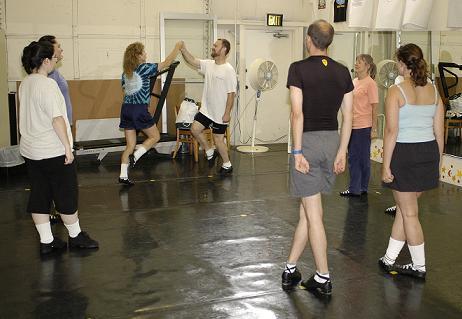 |
| Megan Howard TCRG teaches a beginner adult Irish dance class at Culkin School in Silver Spring, Maryland photo credit Bill H on flickr |
This article first
appeared on IrishCentral.com.
Quick note: Registration for the Shelley Wasatch Winterfeis (February 4, 2012) closes tomorrow, January 21. The TCRG there assured me that they will offer slow speed dances for hard shoes for adult Irish dancers, even though it is not listed on their syllabus. To register, go to www.feisworx.com.
Many feiseanna offer competitions for adult Irish dancers. Here's a quick glance at feiseanna that are friendly to adult Irish dancers in January. Plan on supporting a feis in your area that includes adult Irish dancers and keep an eye out for those feiseanna who are offering slow speed dances for adults.
*source: www.feisworx.com
Key: FF-first feis B-beginner, N-novice, PW-prize winner, O-open championship
Feis New Orleans 2012
New Orleans, LA - Jan 14, 2012
McTeggart, Louisiana
B/BII, N/PW
4 soft shoe
2 hard shoe, traditional speed only
2 hand reel or light jig, 3 hand reel, 4,6,8 book dance
specials: double reel, music, vocal, art, spoken word, baking
Calgary, AB - Jan 20, 2012 to Jan 22, 2012
Blakey School of Irish Dance
B, N, PW
4 soft shoe
2 hard shoe
traditional set
2,3,4,6,8, progressive
specials: treble reel
King-O'Sullivan Winterfeis 2012
Atlanta, GA - Jan 21, 2012
King O'Sullivan School of Irish Dance
B, N, O
3 soft shoe
2 hard shoe
parent/child figure (any)
-------------------READ MORE:
Adult Irish dancer Andria Beauvias from Celtic Steps
Irish dance - a welcoming school day escape
Adult Irish dance team at Villanova University - VIDEOS
--------------------
Wisconsin Winterfeis 2012
Waukesha, WI - Jan 21, 2012
Cashel-Dennehy
B/BII, N/PW
3 soft shoe
2 hard shoe, traditional speeds only
traditional set
figure (any)
Irish Cultural & Heritage Society Feis 2012
Waukesha, WI - Jan 22, 2012
Irish Cultural and Heritage Heritage Center
B/BII, N/PW
3 soft shoe
2 hard shoe, traditional speeds only
traditional set
figure (any)
Colorado WinterFeis 2012
Castle Rock, CO - Jan 27, 2012 to Jan 28, 2012
Wick School
B(over 40), B, N, PW
4 soft shoe
2 hard shoe, traditional speeds only
traditional set
2,3,4,6,8,
specials: trophy (soft shoe and non-trad set)
For North America's favorite Irish dancing magazine delivered directly to your mailbox, subscribe now!
























